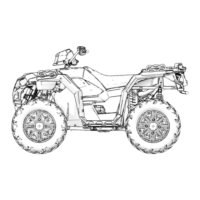11.68
STATOR / ALTERNATOR TESTS
Three tests can be performed using a multimeter to
determine the condition of the stator (alternator).
TEST 1: Resistance Value of Each Stator Leg
1. Measure the resistance value of each of the three
stator legs.
STATOR RESISTANCE VALUES
TEST
CONNECT METER
LEADS TO:
OHMS
READING
Charge Coil Y1 to Y2 (Pin B to C)
0.13 Ω ± 15%
Charge Coil Y1 to Y3 (Pin A to C)
0.13 Ω ± 15%
Charge Coil Y2 to Y3 (Pin A to B)
0.13 Ω ± 15%
NOTE
If there are any significant variations in ohm readings
between the three legs, one of the three stator legs may
be weak or failed.
TEST 2: Resistance Value of Each Stator Leg to
Ground
2. Measure the resistance value of each of the stator
legs to ground.
TEST
CONNECT
METER LEADS
TO:
OHMS
READING
Battery Charge
Coil
Y1, Y2, or Y3
to Ground
Open Line
(Infinity)
NOTE
Any measurement other than Infinity (open) will indicate
a failed or shorted stator leg.
TEST 3: Measure AC Voltage Output of Each
Stator Leg at Charging RPM
3. Set your multimeter meter to measure AC Voltage.
4. Disconnect the 3-wire stator connector near the
stator housing.
5. Start the engine and let it idle.
6. While holding the engine at a specified RPM,
separately measure the voltage across each ‘leg’ of
the stator by connecting the meter leads to the wires
leading from the stator (Y1 to Y2, Y1 to Y3, Y2 to
Y3).
7. Refer to the following table for approximate AC
Voltage readings according to RPM. Test each leg at
the specified RPM in the table.
NOTE
If one or more of the stator leg output AC voltage varies
significantly from the specified value, the stator may
need to be replaced.
RPM
READING
AC VOLTAGE READING
6000
115 Vac ± 10 % (Nominal)
171 Vac ± 10 % (Peak)
ELECTRICAL

